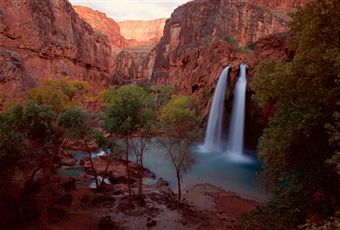تنگه گراند

The Grand Canyon
The Grand Canyon is one of the most spectacular sights in nature. It is found in one section of the valley of the Colorado River. The river begins its course high in the Rocky Mountains of the State of Colorado. The river travels a total of 1,400 miles through Colorado, Utah and Arizona and into the Gulf of California. It forms part of Arizona’s border with Nevada and California. The Colorado River is a very swift and muddy river. It carries dirt and rocks down from the mountains. The story is told of an old fur trader who was attacked by Indians high up the river.
His only escape was down the Colorado River in a small boat. It was a terrifying trip through rapidsand around rocks at top speed. The fur trader was found some days later in very rough shape hundreds of miles down the river. No one would believe that he had come so far so fast. The Grand Canyon stretches for about 250 miles in the State of Arizona. The canyon was carved out by the flow of the river itself. In places the canyon is more than a mile deep. It stretches from four to 18 miles wide at the top. The canyon valley contains worn rocks that rise up like a mountain range. The canyon has been worn down through many layers of rock.
The river has cut its way down through layers of sandstone, limestone and shape to the granitebedrock. The different layers are of different colours, and the rocks appear very beautiful, especially at sunrise and sunset. Because the canyon is so deep, the climate changes as you go down into the valley. At the top, the climate is typical of a mountain area, with evergreen trees. Next, you havetypical forest trees. Third, there are plants like cacti that grow in warm deserts. Finally, there are sub-tropical plants at the valley bottom. Tourists can ride down the narrow trails to the bottom of the valley on mules. On one side is the rock wall of the canyon, and on the other side is a steep drop down to the bottom.
Tourists have to trust their guide, and the mule that they are riding, to get them down safely. The trails zigzag back and forth, and the tourist going down travels much more than a mile. Some 1,000 square miles of the area became the Grand Canyon National Park in 1919. Because the Colorado River is very swift and runs through dry country, several dams have been built along it. These are designed to harness its power, save its water and provide recreational opportunities. The best-known dam is Hoover Dam, formerly Boulder Dam, on the Arizona-Nevada border. This impressive structure is 727 feet high, and 1,282 feet long.
Elevators are used to carry workers up and down inside the dam. The water, which is backed up by the Hoover Dam, forms Lake Mead. Lake Mead is used to irrigate nearby land, as well as for boating and fishing. The dam itself is a major source of electric power for this section of the country. Visitors to the Grand Canyon are often filled with awe by the size and beauty of the canyon. People seem very small in comparison to the immense cliffs, valleys and the mighty river.
spectacular
very impressivea
mountainous area with spectacular scenery
a spectacular success
a spectacular show of military might
—
swift
moving, or able to move, very fast
a swift runner
She wiped her tears away in one swift movement.
this river is too swift for swimming.
—
rapids
part of a river where the water looks white because it is moving very fast over rocks
—
rough
—
stretch
–_
carve out
—
cut its way down
▶REDUCE its LENGTH◀
—
limestone
a type of rock that contains calcium
—
bedrock
solid rock in the ground below soil or sand
—
canyon
a deep valley with very steep sides of rock that usually has a river running through it
–_
evergreen
an evergreen tree or bush does not lose its leaves in winter
—
typical
—
cacti
Plural of cactus
—
trail
rough path across countryside or through a forest
The trail led over Boulder Pass before descending to a lake.
—
mule

an animal that has a donkey and a horse as parents
–_
zigzag
to move forward in sharp angles, first to the left and then to the right etc
The path zigzagged down the hillside.
The path zigzags up the hill.
–_
harness to control and use the natural force or power of something
We can harness the power of the wind to generate electricity.
–__
recreation
an activity that you do for pleasure or amusement
ᅳsee also hobby, pastime, leisureHis only recreations are drinking beer and watching football.
the provision of recreation facilities (=places or equipment for people to use to enjoy themselves) recreation ground/area/room
a recreation area for children to play in
ᅳrecreational adjective recreational activities
—
formerly
in earlier times
ᅳsynonym previously
Kiribati, formerly known as the Gilbert Islands
This elegant hotel was formerly a castle.
–___
backed up
–___
irrigate
to supply land or crops with water
The water in Lake Powell is used to irrigate the area.
irrigated land/farms/crops
–___
awe
a feeling of great respect and liking for someone or something
He felt great awe for the landscape.
with/in awe
Kate gazed at the statue with awe.
–____
mighty
very strong and powerful, or very big and impressive
the mighty Mississippi river
a mighty army